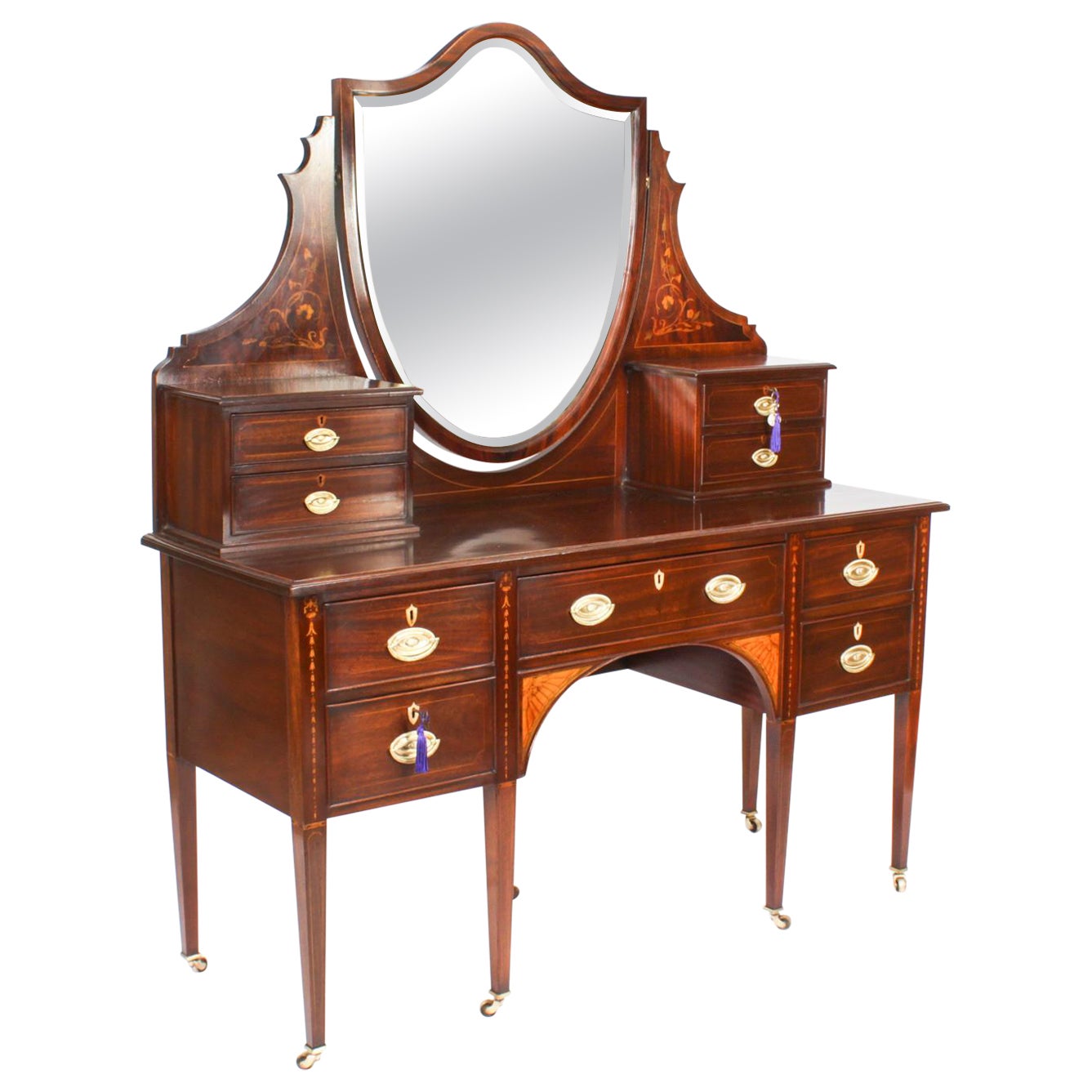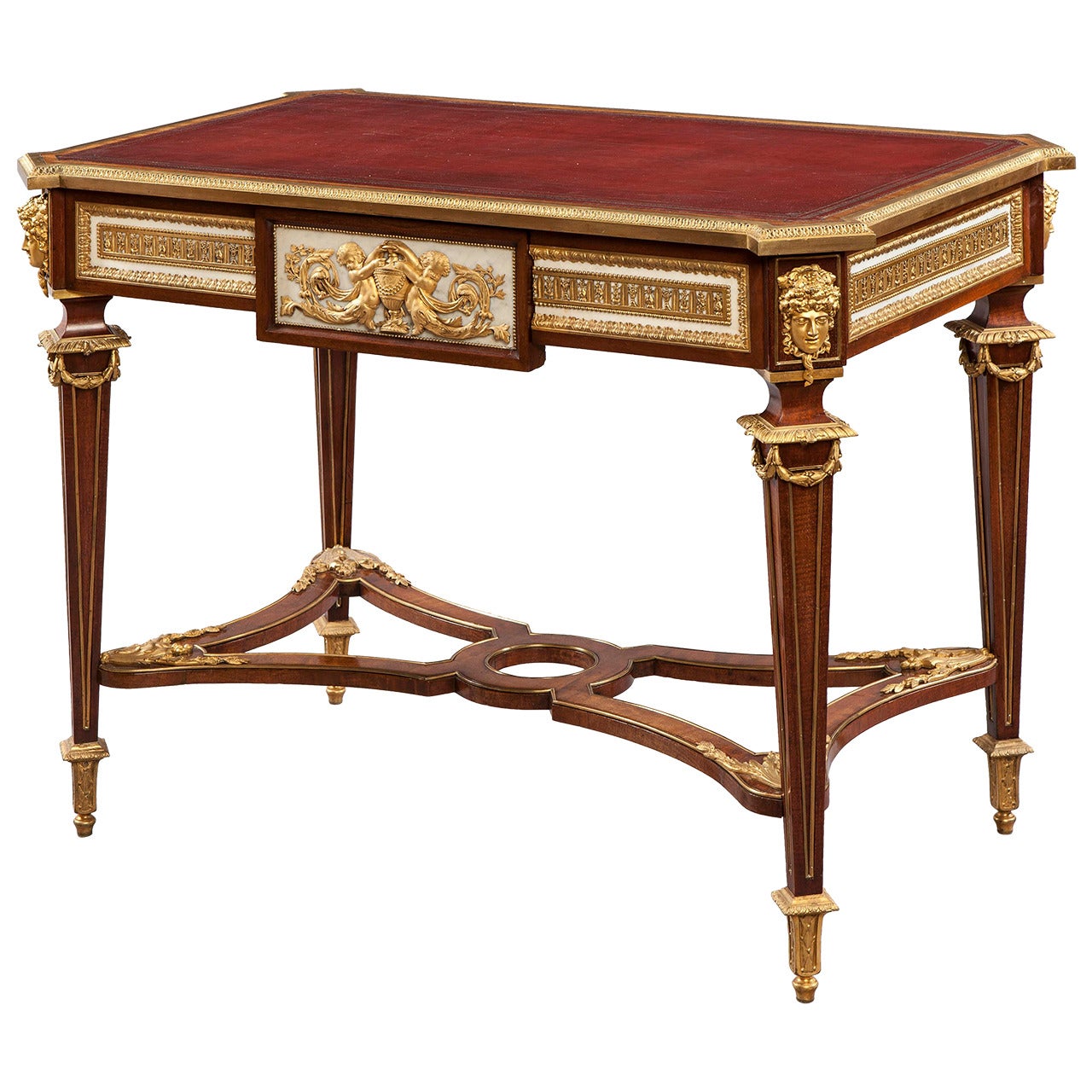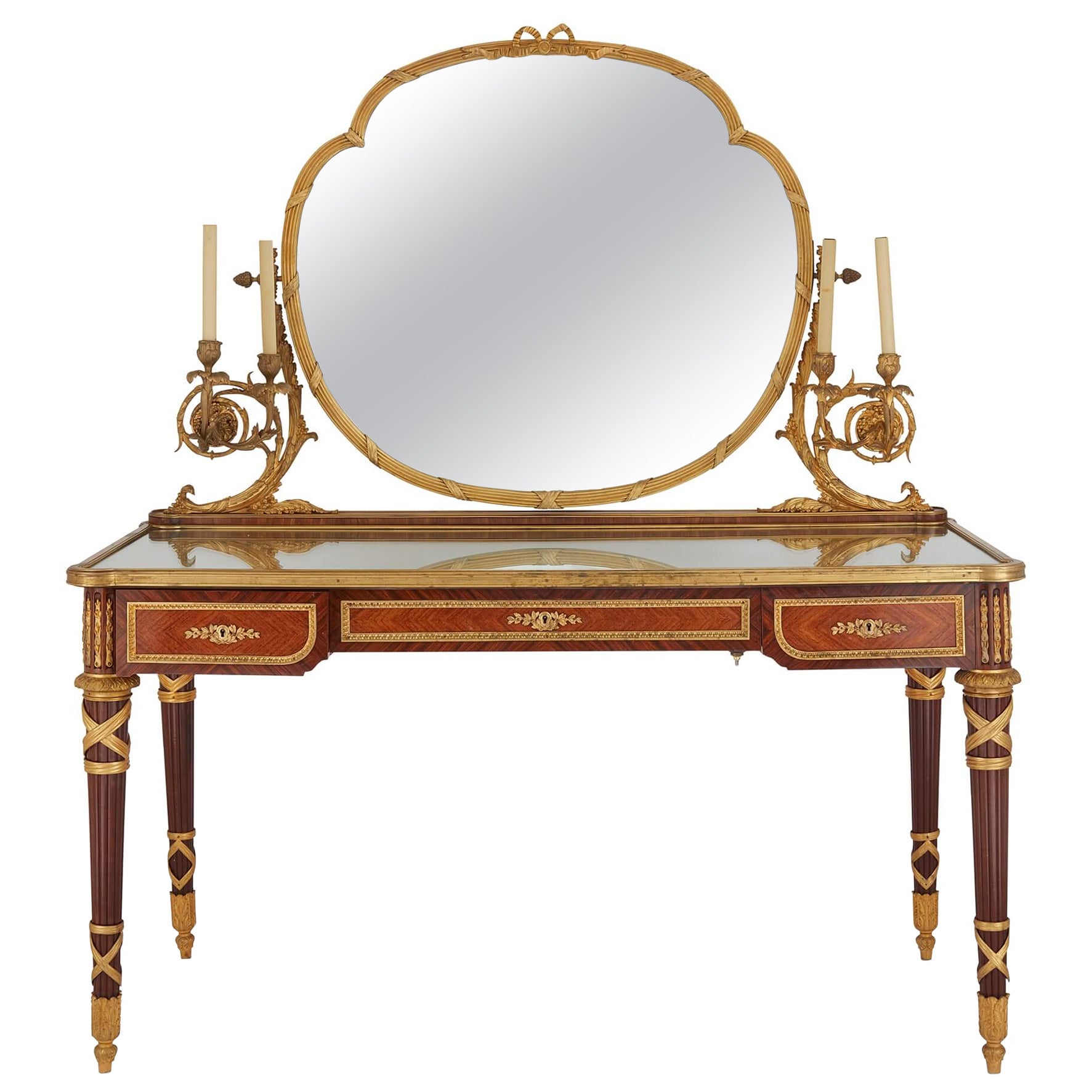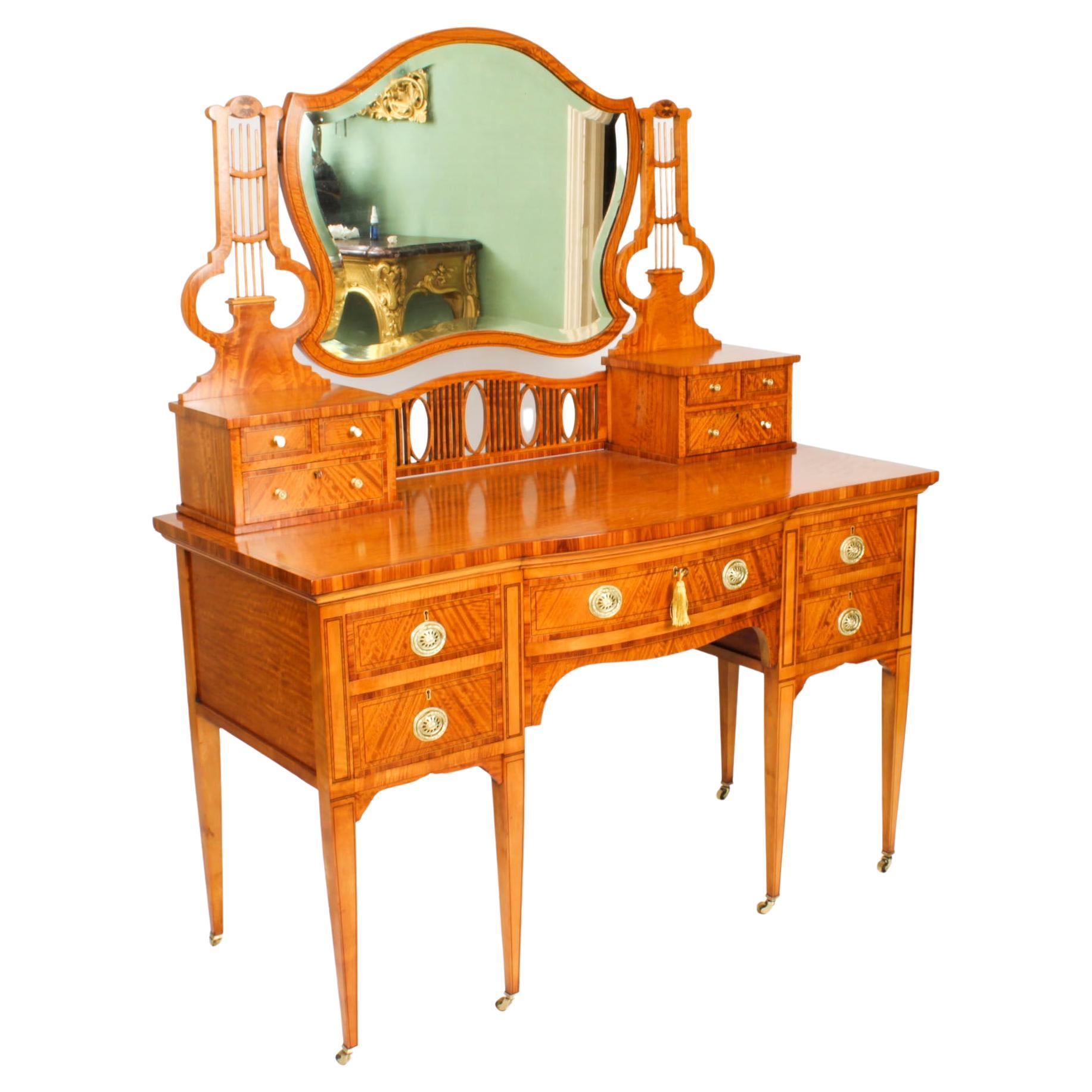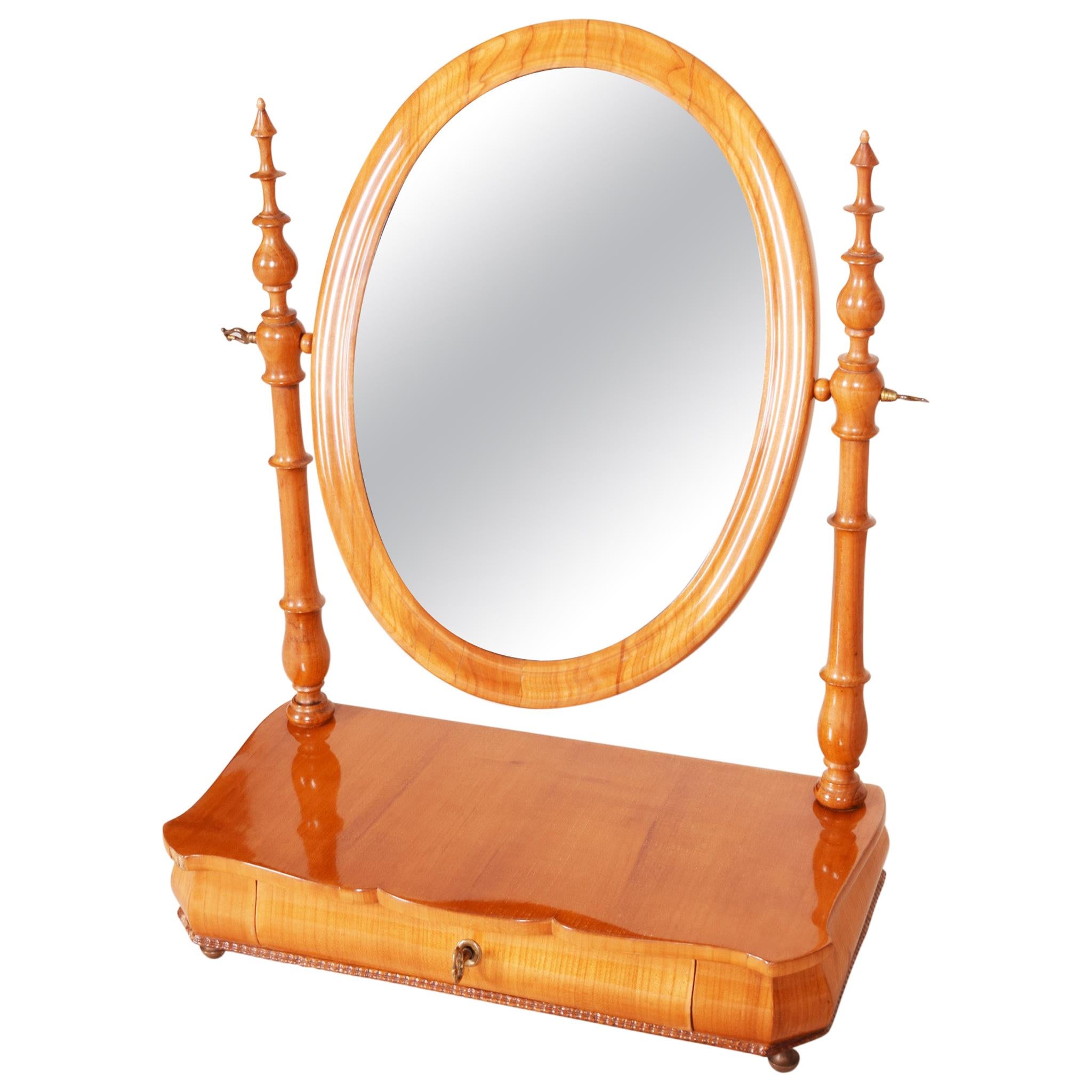Items Similar to Antique Ormolu & Sevres Porcelain Mounted Dressing Table & Mirror 19th Century
Want more images or videos?
Request additional images or videos from the seller
1 of 21
Antique Ormolu & Sevres Porcelain Mounted Dressing Table & Mirror 19th Century
About the Item
This is a beautiful antique French bois de Violette, ormolu and Sevres porcelain mounted dressing table circa 1860 in date.
It has been masterfully crafted from beautiful Bois de Violette highlighted with decorative ormolu banding and ormolu mounted Sevres porcelain plaques that have been hand painted with exotic birds.
The dressing table features a shaped mirror with a pair of petite drawers to the top and a single drawer to the frieze and it is raised on four elegant cabriole legs.
Add a elegant touch to your home with this exceptional piece of antique French furniture.
Condition:
In excellent condition having been beautifully cleaned, polished and waxed in our workshops, please see photos for confirmation.
Dimensions in cm:
Height 147 x Width 78 x Depth 54
Dimensions in inches:
Height 4 foot, 10 inches x Width 2 foot, 7 inches x Depth 1 foot, 9 inches
Bois de Violette
is a classic furniture wood, almost exclusively used for inlays on very fine furniture. Occasionally it is used in the solid for small items and turned work, including parts of billiard cues, e.g., those made by John Parris. It is brownish-purple with many fine darker stripes and occasional irregular swirls. Occasionally it contains pale streaks of a similar colour to sapwood.
The wood is very dense and hard and can be brought to a spectacular finish. it turns well but due to its density and hardness can be difficult to work with hand tools. It also has a tendency to blunt the tools due to its abrasive properties.
Sevres Porcelain
traces its roots in France to early craftsmen who had small manufacturing operations in such places as Lille, Rouen. St. Cloud, and most notably Chantilly. It is from Chantilly that a cadre of workers migrated to the Chateau de Vincennes near Paris to form a larger porcelain manufactory in 1738.
French King Louis XV, perhaps inspired by his rumoured relationship with mistress Madame de Pompadour, took an intense interest in porcelain and moved the operation in 1756 to even larger quarters in the Paris suburb of Sevres. Sevres was also conveniently near the home of Madame de Pompadour and the King's own Palace at Versailles.
From the outset the king's clear aim was to produce Sevres Porcelain that surpassed the established Saxony works of Meissen and Dresden. Though the French lacked an ample supply of kaolin, a required ingredient for hard-paste porcelain (pate dure), their soft-paste porcelain (pate tendre) was fired at a lower temperature and was thus compatible with a wider variety of colours and glazes that in many cases were also richer and more vivid. Unglazed white Sevres Porcelain "biscuit" figurines were also a great success. However, soft-paste Sevres Porcelain was more easily broken. Therefore, early pieces of Sevres Porcelain that remain intact have become rare indeed.
The Sevres Porcelain manufactory always seemed to be in dire financial straits despite the incredibly fine works it produced. In fact, the king's insistence that only the finest items be created may have contributed to the difficulties. Only a limited number of European nobility could afford the extravagant prices demanded for such works. King Louis XV and eventually his heir, the ill-fated Louis XVI, were obliged to invest heavily in the enterprise. Ultimately, the Sevres Porcelain Factory produced items under the name of "Royal" and thus the well-known Sevres mark was born. King Louis XV even mandated laws that severely restricted other porcelain production in France so as to retain a near monopoly for his Sevres Porcelain. The king even willingly became chief salesman for the finest of his products, hosting an annual New Year's Day showing for French nobility in his private quarters at Versailles. He eagerly circulated among potential buyers, pitching the merits of ownership and policing the occasional light-fingered guest.
Sevres Porcelain may have indeed given the makers of Meissen and Dresden a run for their money by the end of the 18th Century but for the French Revolution. By 1800, the Sevres Porcelain Works were practically out of business due to the economic devastation of the new French Republic.
About the time when Napoleon Bonaparte named himself Emperor of France (1804), a new director was named for the Sevres Porcelain Manufactory. Alexandre Brongniart, highly educated in many fields, resurrected Sevres Porcelain. Soft-paste porcelain was eliminated altogether thanks to the earlier discovery of kaolin near Limoges. For four decades until his death, Brongniart presided over monumental progress for Sevres Porcelain, catering not only to Napoleon himself, but at last to include the more financially profitable mid-priced market in the emerging middle class.
Ormolu - (from French 'or moulu', signifying ground or pounded gold) is an 18th-century English term for applying finely ground, high-carat gold in a mercury amalgam to an object of bronze.The mercury is driven off in a kiln leaving behind a gold-coloured veneer known as 'gilt bronze'.
The manufacture of true ormolu employs a process known as mercury-gilding or fire-gilding, in which a solution of nitrate of mercury is applied to a piece of copper, brass, or bronze, followed by the application of an amalgam of gold and mercury. The item was then exposed to extreme heat until the mercury burned off and the gold remained, adhered to the metal object.
Our reference: A3453
- Dimensions:Height: 57.88 in (147 cm)Width: 30.71 in (78 cm)Depth: 21.26 in (54 cm)
- Materials and Techniques:Ormolu,Porcelain
- Period:1860-1869
- Date of Manufacture:Circa 1860
- Condition:
- Seller Location:London, GB
- Reference Number:
About the Seller
5.0
Platinum Seller
These expertly vetted sellers are 1stDibs' most experienced sellers and are rated highest by our customers.
Established in 1983
1stDibs seller since 2012
1,199 sales on 1stDibs
Typical response time: <1 hour
Associations
LAPADA - The Association of Arts & Antiques Dealers
- ShippingRetrieving quote...Ships From: London, United Kingdom
- Return PolicyA return for this item may be initiated within 14 days of delivery.
More From This SellerView All
- Antique Pair Sevres Porcelain Mounted Ormolu Candlesticks 19th CenturyLocated in London, GBThis is a delightful antique pair of 19th century French Sevres porcelain mounted ormolu candlesticks, C1870 in date. The square bases and plain column stems with tulip sconces d...Category
Antique 1870s French Porcelain
MaterialsOrmolu
- Antique Late Victorian Mahogany Dressing Table & Mirror 19th CLocated in London, GBThis is a totally fabulous Antique Late Victorian Sheraton Revival Mahogany and Marquetry dressing table, circa 1890 in date. THE BOTANICAL NAME FOR THE MAHOGANY THAT THIS DRESSI...Category
Antique 1890s English Victorian Tables
MaterialsMahogany
- Antique French Sevres Porcelain Ormolu Mounted Planter Jardiniere 19th CenturyLocated in London, GBThis is a superb antique French Louis XV revival ormolu and Sevres porcelain mounted, wood jardiniere, circa 1860 in date. This beautiful shaped planter has splendid ormolu mounts ...Category
Antique 19th Century French Louis XV Pedestals and Columns
MaterialsOrmolu
- Antique Inlaid Satinwood Dressing Table Maple & Co 19th CenturyBy Maple & Co.Located in London, GBThis is a fine antique satinwood serpentine fronted dressing table by the world renowned cabinet maker an retailer Maple & Co, Circa 1880 in date. The stunning satinwood dressing t...Category
Antique Early 1800s Tables
MaterialsSatinwood
- Antique Bleu Royale Sèvres Porcelain Ormolu Table Lamp, 19th CenturyLocated in London, GBThis is a stunning large antique French Sèvres "Bleu Royale" hand painted porcelain and ormolu-mounted vase circa 1870 in date, later converted into a lamp. The ovoid porcelain bo...Category
Antique 1870s French Porcelain
MaterialsOrmolu
- Antique Bleu Celeste Sevres Porcelain Ormolu Table Lamp 19th CenturyLocated in London, GBThis is a stunning large antique French Sevres hand-painted porcelain and ormolu mounted vase circa 1870 in date, later converted into a lamp. The ovoid porcelain body is painted...Category
Antique 1870s French Table Lamps
MaterialsOnyx, Ormolu
You May Also Like
- 19th Century Mahogany, Marble and Ormolu-Mounted Writing TableLocated in London, GBA bureau plat in the Louis XVI manner Constructed in mahogany, Carrara marble, and extensively dressed with fine ormolu mounts; of freestanding rectangular form, rising from field...Category
Antique 19th Century British Louis XVI Tables
MaterialsCarrara Marble, Ormolu
- Antique Ormolu Mounted Dressing Table by Zwiener Jansen SuccesserBy Zwiener Jansen SuccesseurLocated in London, GBAntique ormolu mounted dressing table by Zwiener Jansen Successeur French, c. 1900 Height 153cm, width 134cm, depth 63cm Superbly crafted by the renowned French firm Zwiener Jans...Category
Early 20th Century French Louis XVI Tables
MaterialsOrmolu
- French 19th Century Louis XV Style Kingwood, Tulipwood and Ormolu Dressing TableLocated in West Palm Beach, FLA beautiful and extremely elegant French 19th century Louis XV style kingwood, tulipwood and ormolu dressing table. The table is raised by slender cabriole legs with Fine wraparound ...Category
Antique 19th Century French Louis XV Tables
MaterialsOrmolu
- 19th Century Biedermeier Restored Cherry Czech Mirror Dressing Table, 1860sLocated in Horomerice, CZBiedermeier restored mirror dressing table Period: 1860-1869 Source: Czechia (Bohemia) Material: Cherry-tree.Category
Antique 19th Century Czech Biedermeier Tables
MaterialsCherry, Mirror, Lacquer
- 19th Century French Marquetry & Bronze Dressing TableLocated in Marbella, ESAntique 19th century French marquetry and bronze dressing table.Category
Antique 19th Century French Desks and Writing Tables
MaterialsWood
- French 19th Century Empire-Style Dressing TableLocated in Baton Rouge, LAThis exceptional mahogany dressing table is complete with its original mercury glass pivoting mirror and white marble top. The mirror has foxing and is framed with beautiful mahogany...Category
Antique 19th Century French Empire Vanities
MaterialsMahogany
